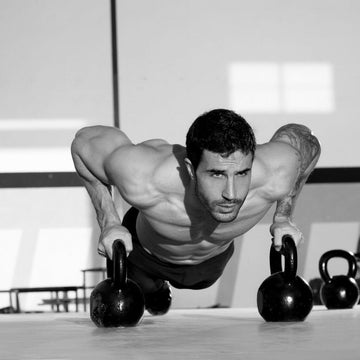Push-ups – the ideal full-body workout
Push-ups train more than just the biceps and shoulders. The buttocks, chest muscles and back are also strengthened by this strength exercise. Due to this whole-body training feature, push-ups mean that you can do without a lot of fitness equipment.
In this article you will find all the important information about this classic of strength training.
What do push-ups do
Push-ups, also known as press-ups, are a popular bodyweight exercise that works several muscle groups in the upper body, core, and even the legs. The main muscles used in push-ups are:
- Chest muscles (pectorales): The chest muscles are the main muscles that work during push-ups. They are responsible for extending and stabilizing the arms during the movement.
- Triceps (triceps brachii): The triceps is the muscle on the back of the upper arm. It is responsible for extending the elbow joint, which is an essential part of the push-up movement.
- Shoulder muscles (deltoids): The anterior deltoid muscles, which form the front shoulder area, help stabilize and lift the arms during push-ups.
- Core muscles: Push-ups also work the core muscles, including the rectus abdominis, obliques, and lower back muscles. These muscles are important for stabilizing the body and maintaining a solid plank position during the exercise.
- Leg and hip muscles: Although they are not the main muscles used in push-ups, the leg and hip muscles are also involved in the exercise as they help keep the body stable and in a straight line.
- Chest muscles
- Shoulder
- Triceps
- biceps
- Gluteal muscles
- hull
- Abdominal muscles
- Beginners: If you're just starting out, you may only be able to do a few push-ups (3-5) with correct form at first. This is completely normal. Work on improving your strength and endurance by adding more reps over time.
- Average Fitness: A person with average fitness should be able to perform 10-20 push-ups without stopping.
- Good fitness: People with good physical fitness can usually do 20-40 push-ups without stopping.
- Excellent fitness: People with excellent physical fitness can often perform 40-60 or more push-ups without rest.
Push-ups can be effective in building muscle, especially in the upper body and core. They are a bodyweight exercise that works and trains several muscle groups at once. The main muscles involved in push-ups include:
- Chest muscles (pectorales): Push-ups primarily train the chest muscles and can help make these muscles stronger and larger.
- Triceps (triceps brachii): Push-ups also work the triceps, the muscle at the back of the upper arm, and can help build these muscles.
- Shoulder muscles (deltoids): The front deltoid muscles, which form the front shoulder area, are also used during push-ups and can be strengthened and built up through regular training.
- Core: Push-ups also work the core muscles, including the rectus abdominis, obliques, and lower back muscles. This can lead to a stronger and more toned-looking core.
- Leg and hip muscles: Although they are not the main muscles used in push-ups, the leg and hip muscles are also involved in the exercise as they help keep the body stable and in a straight line.





